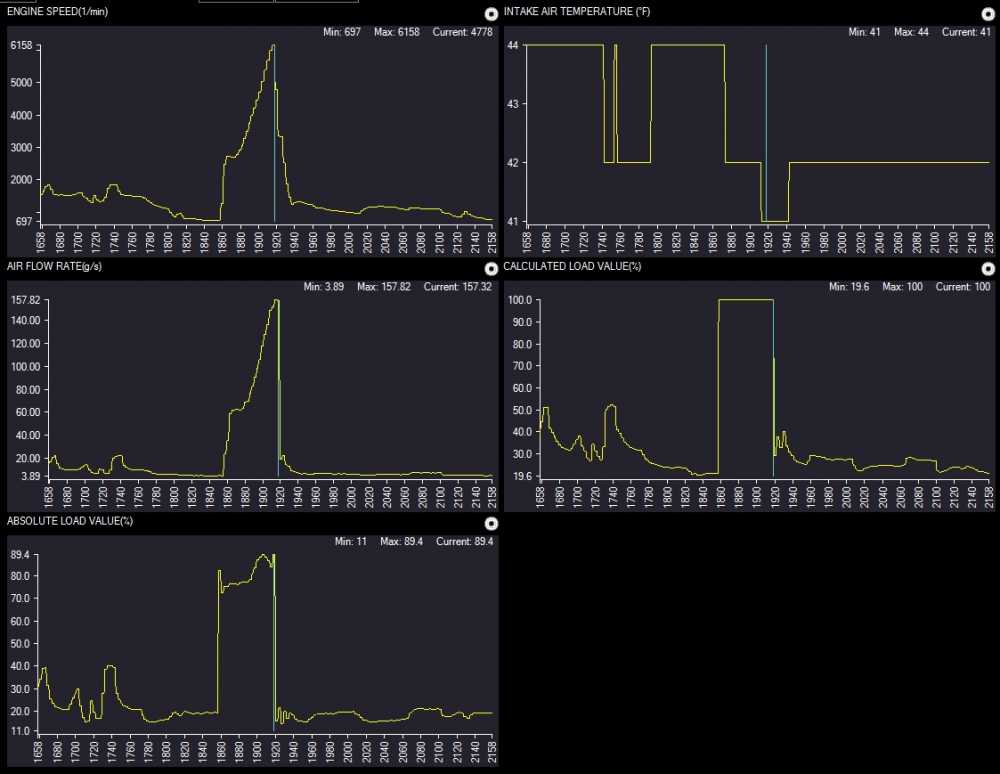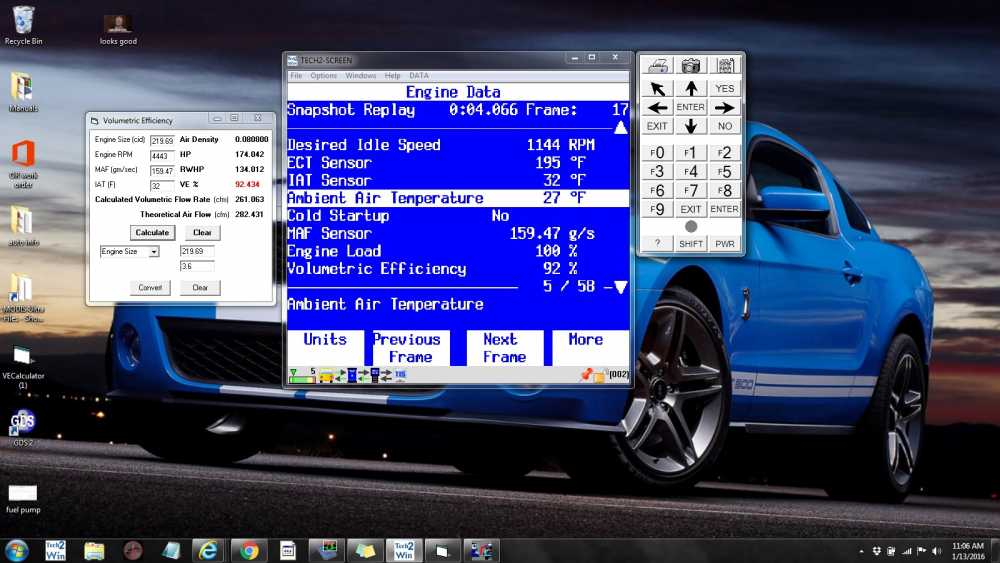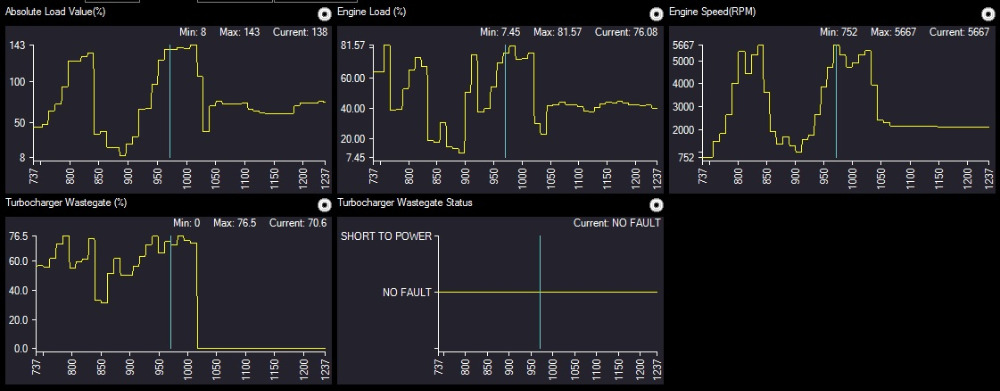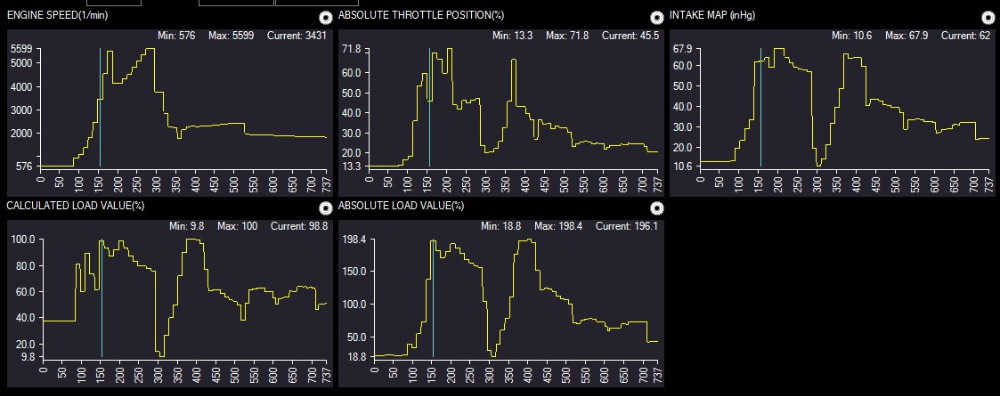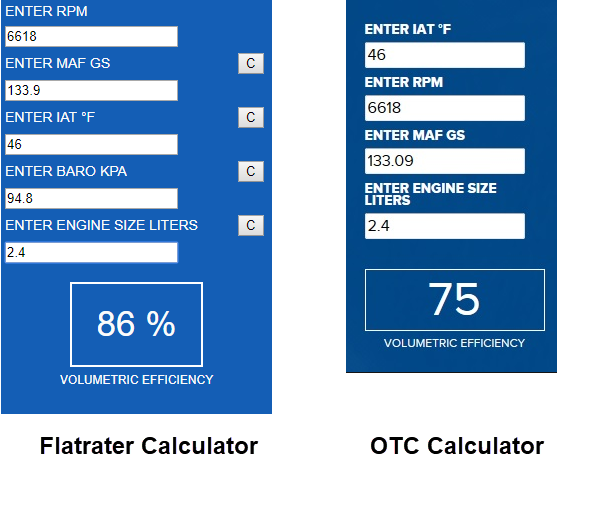Calculated Load vs. Absolute Load
Please Log in or Create an account to join the conversation.
gav09 wrote: I have a screenshot of a Tech 2 screen with the VE pid vs VE calculator and it is really close. I'll grab it off my other computer tomorrow.
Cool. I'd like to see that screenshot
Please Log in or Create an account to join the conversation.
- Posts: 5830
- Thank you received: 1420
gav09 wrote: I have a screenshot of a Tech 2 screen with the VE pid vs VE calculator and it is really close. I'll grab it off my other computer tomorrow.
I've seen that before! Very nice of GM to add that PID. But not all have it?
Decided to play a bit more with Absolute Load, this time on an '08 Escape. 3.0L engine, no VVT.
89% at the peak. This kinda makes sense compared to the '11 Enclave I tested earlier, which is supposed to use it's VVT at WOT to improve VE.
Still trying to build a baseline for what this PID should be doing on different engines. Maybe 80 - 90% for non-VVT engines, 90 - 105% for VVT?
Please Log in or Create an account to join the conversation.
- Posts: 4413
- Thank you received: 958
New guinea pig is working out good I take it :whistle:Decided to play a bit more with Absolute Load, this time on an '08 Escape. 3.0L engine
"Ground cannot be checked with a 10mm socket"
Please Log in or Create an account to join the conversation.
- Posts: 5830
- Thank you received: 1420
Please Log in or Create an account to join the conversation.
Please Log in or Create an account to join the conversation.
- Posts: 5830
- Thank you received: 1420
gav09 wrote: Sorry about the delay but here is the screenshot. I don't remember what vehicle it was but 92.434% on the calculator and 92% on the scan data.
Sweet!
I wonder if they're actually taking the Absolute Load PID from Global and renaming it Volumetric Efficiency in Enhanced data? :huh:
Please Log in or Create an account to join the conversation.
gav09 wrote: Sorry about the delay but here is the screenshot. I don't remember what vehicle it was but 92.434% on the calculator and 92% on the scan data.
Thanks! Karma bump for you.
I'm also using Tech2 and I haven't noticed this PID... I'll keep it in mind that's for sure. Your VE calculator is from Windows store? Just asking cause we're talking about calculators since Tyler revealed that the one from OTC is crap and so we're on the hunt for a good one :lol:
Tyler wrote:
I wonder if they're actually taking the Absolute Load PID from Global and renaming it Volumetric Efficiency in Enhanced data? :huh:
Good question :S
Please Log in or Create an account to join the conversation.
COOL! Check this one out guys :woohoo:
Please Log in or Create an account to join the conversation.
- ScannerDanner
-

- Offline
- Administrator
-

- Religion says do, Jesus says done!
- Posts: 937
- Thank you received: 484
Don't be a parts changer!
Please Log in or Create an account to join the conversation.
- Posts: 5830
- Thank you received: 1420
I also learned at Vision that Absolute Load is very useful for forced induction diagnostics, particularly on newer Ford EcoBoost engines. I'm told that a peak Absolute Load of 150-175% is typical on Ecoboost platforms. I ran into a '13 Edge with a turbocharger issue recently that became much more obvious once I started looking at Absolute Load.
This one had a wastegate problem that prevented maximum boost, and resulted in a DTC.
This shot is off a 'chipped' 3.5L F-150. Almost hit 200% Absolute Load. :ohmy:
Please Log in or Create an account to join the conversation.
- matt.white
-
- Offline
- Elite Member
-

- Posts: 220
- Thank you received: 29
Also, my understanding of this VE calculator is stripping back fuel delivery and spark timing and simply measuring the engine as an air pump. You guys agree that's a fair comparison?
Please Log in or Create an account to join the conversation.
matt.white wrote: Also, my understanding of this VE calculator is stripping back fuel delivery and spark timing and simply measuring the engine as an air pump. You guys agree that's a fair comparison?
I agree Matt. Volumetric efficiency is basically an indication how well an engine breathes. I don't consider it as a magic calculation that will solve our problems in the blink of an eye
Please Log in or Create an account to join the conversation.
- Posts: 5830
- Thank you received: 1420
matt.white wrote: Just watching Pauls video, there's huge discrepancies between the load data shown between the 3 vehicles. From memory the F150 peaked at 89%, his ute reached 99% but seem to be fairly related to what was being asked of the motor. The Lincoln however really seemed to jump around a lot and reach 100% when it didn't seem to be under any load. Just an observation.
Good observation, sir! I've seen maximum Load vary between makes on known good vehicles, possibly due to variations in inputs? Most Ford vehicles won't go to 95-100% Load, but GM's usually will. Not sure what was up with the Lincoln... I'd know more if I knew which engine it had in it. Many newer vehicles will clear 100% Load due to VVT and forced induction.
Also, my understanding of this VE calculator is stripping back fuel delivery and spark timing and simply measuring the engine as an air pump. You guys agree that's a fair comparison?
Sorta? The trouble is that the VE calculation is based largely on the MAF reading, which can misreport (dirty, skewed, whatever). The VE test can't make a distinction between a pumping problem and a measurement problem. But, neither can Load. :silly:
Please Log in or Create an account to join the conversation.
- Pontisteve
-
- Offline
- New Member
-

- Posts: 3
- Thank you received: 4
When you're using these VE calculators, there's something you should keep in mind. Peak torque happens at an RPM well below where peak HP occurs. For example, on an LS V8 Chevy engine, peak torque typically occurs around 4500 RPM, while peak HP might occur at 6500 RPM.
Every motor has a sweet spot where it's the most efficient air pump. As you climb towards this peak efficiency point, airflow goes up. Above peak efficiency, airflow actual begins to go down. The Torque curve of the engine shows this.
When you measure maximum engine airflow, that airflow will occur right around peak torque. When you measure this peak mass airflow, you should also record the engine RPM at that same point, and use it in the volumetric efficiency calculators.
Please Log in or Create an account to join the conversation.
- Pontisteve
-
- Offline
- New Member
-

- Posts: 3
- Thank you received: 4
www.facebook.com/DragRadialPerformance/posts/1365727770187096
I also made an Excel spreadsheet that calculates VE for you, which is available for free if you ask. In version 1.00, I added barometric pressure compensation. I may add air temp compensation in the near future. Currently, the program assumes standard temperature (59F).
Please Log in or Create an account to join the conversation.
Please Log in or Create an account to join the conversation.
If I'm understanding you correctly here, I would have to disagree.
If you assume...
WOT is either enrichment mode or CL
An O2 will switch high > stoich
For a skewed MAF to affect VE to any useful level, it will have to have a significant error
Then I think the problem is solved. I have been using and teaching this with examples for a long time.
Please Log in or Create an account to join the conversation.
Per the J1979 definition, it is a "normalized" value.
Normalization of a data set I believe brings a good bit of value, but it does take some explaining.
I have a long term project on just this topic and it will likely end up being part of a new class.
I don't really care for generic data as it is so slow, so I've always used whatever definition of engine load the OE side of the scan tool uses and use other pids to give it context. The reason for the project is that I have to address this stuff industry wide, not just for myself.
I think I saw that you posted numerous GM examples. I have found GM to use at least 4 different engine load definitions, all with the same pid name. Other OEs seem to be a little less haphazard
Please Log in or Create an account to join the conversation.
Sorry Tyler, I didn't realize I hadn't read to the end of the thread
Please Log in or Create an account to join the conversation.


